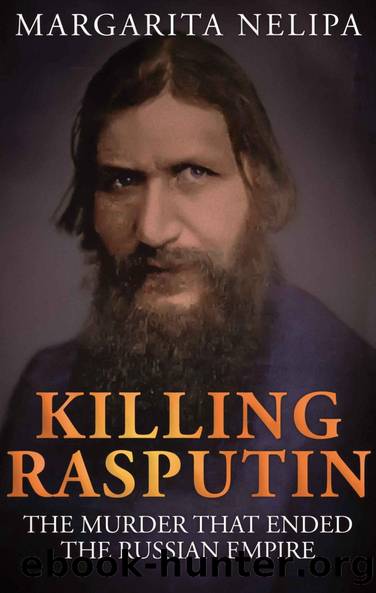Killing Rasputin by Margarita Nelipa

Author:Margarita Nelipa [Nelipa, Margarita]
Language: eng
Format: epub
ISBN: 9781942266686
Google: GIEZtAEACAAJ
Publisher: WildBlue Press
Published: 2017-05-30T00:28:57+00:00
CHAPTER EIGHT
The Autopsy Conducted on Rasputinâs body and the Forensic Evaluation
Most biographers omit indepth discussion about the injuries that Rasputinâs body sustained. Several assure readers that Rasputin was alive when he was thrown into the water and that his frozen right hand was poised as if he was about to offer his blessing at the moment of his death.1314,1315,1316 This myth was advanced with the suggestion the empress did not want an autopsy to be carried out because it prevented the church deliberating about his sainthood. In 2006, French journalist Alain Deceaux1317 wrote about enigmas around the world. In one sketch, he spread the mythmaking, saying that after Rasputin was raised from the ice, âhis lungs were filled with water ⦠this indicates that Rasputin died by drowning.â Shamefully, such myths disregard the forensic evidence that was published in Russia in 1917.
Preliminary Preparation
Given that it took two hours before a doctor arrived at the second crime scene, âduring that time the corpse froze completely,â1318 it needed time to thaw sufficiently before an autopsy could take place. The next day, Tuesday, at around 9 p.m., the arms of the deceased could be lowered;1319 therefore, Professor Kosorotov was immediately notified that he was to conduct the autopsy procedure.
After the remains were identified on Monday 19 December, Sereda sent a letter to Professor Kosorotov instructing him to prepare for a special secret forensic examination on a corpse that would be conducted on 21 December.1320 During the next day, Tuesday, Kosorotov arranged that his instruments and fresh solutions would be sent from the Imperial Military Medical Academy where he worked to the Chesmenskii Almshouse.1321 At 7 p.m., Kosorotov received a telephone call telling him the autopsy had to be performed without further delay. Zavadsky and Sereda collected Kosorotov in their own vehicle from the function he was attending. It was not until ten oâclock when Professor Kosorotov (Photo 23) was able to begin the autopsy. The purpose of that procedure was to ascertain Rasputinâs cause of death. To maintain secrecy,1322 the autopsy could not be deferred until daytime. The dissection took roughly four hours, ending early on Wednesday morning, 21 December. To help with the thawing process, the room in which the autopsy would be conducted had to be heated to 20°Ré or 25C/77F. [The Réaumur scale was widely used in Europe at the time.]
The Credentials, the Professor of Forensic Medicine
Kosorotov completed his studies at the Medical-Surgical Academy in 1879. Within eight years, in 1887, he was appointed assistant to the St. Petersburg Military Clinic Hospital. During that period, he proved to be a prolific author, editing the Russian Medical Journal, and in 1900, published âFundamental guide for compiling forensic-medical reports for the post-mortemsâ and followed that work with his textbook âToxicologyâ in 1911. In 1898, he became chaired professor of Forensic Medicine and toxicology at the St. Petersburg Imperial Military Medical Academy, then the chief dissector. From the beginning of the twentieth century, Kosorotov was recognized as one of the leading forensic experts in Russia.
Download
This site does not store any files on its server. We only index and link to content provided by other sites. Please contact the content providers to delete copyright contents if any and email us, we'll remove relevant links or contents immediately.
| France | Germany |
| Great Britain | Greece |
| Italy | Rome |
| Russia | Spain & Portugal |
Fanny Burney by Claire Harman(26531)
Empire of the Sikhs by Patwant Singh(22980)
Out of India by Michael Foss(16792)
Leonardo da Vinci by Walter Isaacson(13189)
Small Great Things by Jodi Picoult(7024)
The Six Wives Of Henry VIII (WOMEN IN HISTORY) by Fraser Antonia(5400)
The Wind in My Hair by Masih Alinejad(5034)
A Higher Loyalty: Truth, Lies, and Leadership by James Comey(4851)
The Lonely City by Olivia Laing(4751)
The Crown by Robert Lacey(4731)
Millionaire: The Philanderer, Gambler, and Duelist Who Invented Modern Finance by Janet Gleeson(4386)
The Iron Duke by The Iron Duke(4294)
Papillon (English) by Henri Charrière(4199)
Sticky Fingers by Joe Hagan(4106)
Joan of Arc by Mary Gordon(4022)
Alive: The Story of the Andes Survivors by Piers Paul Read(3970)
Stalin by Stephen Kotkin(3883)
Aleister Crowley: The Biography by Tobias Churton(3589)
Ants Among Elephants by Sujatha Gidla(3417)
